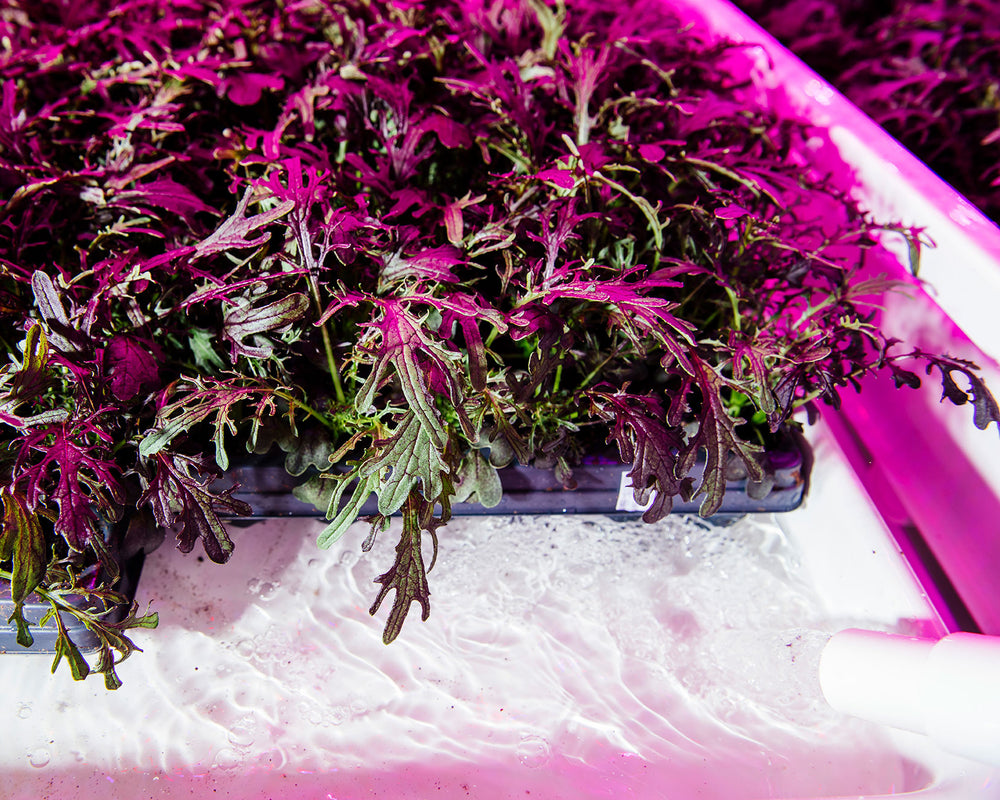
Nicole, our CEA Design & Development Associate, has been researching ways to improve our sustainability practices and reduce our carbon footprint. In this blog post, she details how the controlled environment agriculture industry can become more sustainable as the systems around us begin to utilize more renewable energy sources.

Making eco-friendly and sustainable choices can be a delicate balancing act. Often, a service, product, or technology that solves one environmental problem contributes to another. For example, if we bring reusable cotton bags to the grocery store, we avoid single-use plastic and feel good about not contributing to the local landfill. However, manufacturing one reusable cotton bag has a carbon footprint at least 170 times higher than manufacturing one plastic bag. We would need to remember our reusable bag 170 times before we break even from an emissions perspective.
This simple situation highlights two really important ideas in sustainability that can help us understand the environmental case for vertical farming (VF).
The first idea is that humans are putting a lot of different pressures on our natural environment. In the bag metaphor, it isn’t just the plastic waste or just the carbon emissions that we’re worried about, we need to address both. Agriculture has way more than two issues to balance, like land degradation, food waste, fertilizer and pesticide overuse, deforestation, and water depletion, just to name a few.
Agriculture accounts for 21-37% of greenhouse gas emissions globally and around 70% of water use. As we begin to feel the effects of climate change, traditional outdoor agriculture also faces changing growing seasons and increased crop loss due to extreme weather events. This causes a lot of strain on our current food system’s ability to feed the world reliably and equitably.
Longer growing seasons and resilience to extreme weather events are key benefits of controlled environment agriculture (CEA). Hydroponic CEA also significantly reduces water use compared to traditional agriculture. In traditional ag, the entire area needs to be irrigated in order for water to reach the plant’s roots, whereas hydroponics allows us to target the roots directly. After irrigation, any remaining water not absorbed by the plant can be reclaimed and recycled for reuse. Precise irrigation and water reuse also combats the excessive fertilizer runoff of traditional ag, which leads to many water quality problems. At Planted Detroit, our irrigation water is constantly treated and reused in a closed-loop cycle that is only broken for routine cleaning. Our newest farm, which is set to open in 2023, will have additional water reclamation technology that captures water lost to evaporation and condenses it for reuse.
Planted Detroit also pursues resource conservation through our new waste management program. All of the inedible biomass that we produce, such as plant roots and used growing media, is collected for compost and given to other urban farms in Detroit for reuse. All of our food waste is also collected for compost as we strive to send no organic waste to the landfill. We collect all of our recyclable materials through Detroit Recycles, and are committed to promoting recycling education among our staff.
In addition to being a hydroponic controlled environment agriculture (CEA) farm, Planted Detroit is also a vertical farm. Because we can stack growing areas on top of each other, vertical farming takes up a smaller footprint and can be located in urban centers, significantly shortening the supply chain from farm to consumer. This is one of the major benefits of vertical farming - as opposed to shipping greens more than 3,000 miles from California, we can grow right in Detroit and sell our products to Detroiters the same day they’re harvested! This provides fresher, more nutritious food, reduces food waste due to spoilage, and relieves pressures on land conversion, deforestation, and arable land degradation.
Vertical farming presents a solution to many of traditional ag’s problems, but since it relies on artificial lighting and climate control, vertical farming requires significantly more energy input and therefore has higher carbon emissions. Many studies have attempted to determine if the advantages of vertical farming outweigh its high energy use, but these “apples to oranges” comparisons are difficult to quantify, and they also lead to a lot of greenwashing in the VF industry. What we do know is that in terms of simple carbon emissions, vertical farming is a larger emitter than traditional ag unless the vertical farm can use renewable energy.
This leads into the second big idea from the shopping bag metaphor - the idea that technology itself, whether a cotton bag or an ultra high-tech indoor farm, is not enough to solve environmental problems on its own. Our behaviors and systems need to change as well. Charging 5-10 cents for a single-use plastic bag has been shown to significantly improve reusable bag use. The systemic change supports more sustainable outcomes, and the same can happen for vertical farming when we build a more sustainable energy grid.
Michigan has a long way to go to develop its systemic support for clean energy use. As of 2021, Michigan only got 11% of its energy from renewables. However, the current state goal for Michigan is to reach 60% renewable energy production by 2030. Studies have shown that 90% of VF’s carbon emissions come from its energy use, so this upcoming shift in power generation will change everything.
For an idea of just how big this shift in energy production could be for VF carbon emissions, we look to an example out of Scotland. A scientific study explored the carbon intensity of vertical farming in Scotland across multiple years. In 2017, 53% of Scottish energy came from renewables, and that increased to 98.6% in 2020. The shift in energy production caused the carbon intensity of vertically farmed lettuce to drop by 81%. As our own energy grids shift away from fossil fuels, the environmental viability of vertical farming will continue to grow.
While vertical farming today can help solve issues of land degradation, fertilizer overuse, fresh water depletion, food insecurity, etc., vertical farming of the future will be able to do all of that on a renewable, zero-emissions electricity grid. With the right behavior, policies, and systems in place, vertical farming has the potential to be a local, resilient, and sustainable solution to feed the world. We’re building the foundation right now, and very excited to see where the future takes us.
P.S. Don’t forget your reusable grocery bag!



